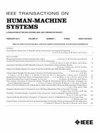Extracting Human Levels of Trust in Human–Swarm Interaction Using EEG Signals
IF 3.5
3区 计算机科学
Q2 COMPUTER SCIENCE, ARTIFICIAL INTELLIGENCE
引用次数: 0
Abstract
Trust is an essential building block of human civilization. However, when it relates to artificial systems, it has been a barrier to intelligent technology adoption in general. This article addresses the gap in determining levels of trust in scenarios that include humans interacting with a swarm of robots. Electroencephalography (EEG) recordings of the human observers of the different swarms allow for extracting specific EEG features related to different trust levels. Feature selection and machine learning methods comprise a classification system that would allow recognition of different levels of human trust in those human–swarm interaction scenarios. The results of this study suggest that EEG correlates of swarm trust exist and are distinguishable in machine learning feature classification with very high accuracy. Moreover, comparing common EEG features across all human subjects used in this study allows for the generalization of the classification method, providing solid evidence of specific areas and features of the human brain where activations are related to levels of human–swarm trust. This work has direct implications for effective human–machine teaming with applications to many fields, such as exploration, search and rescue operations, surveillance, environmental monitoring, and defense. In these applications, quantifying levels of human trust in the deployed swarm is of utmost importance because it can lead to swarm controllers that adapt their output based on the human's perceived trust level.利用脑电信号提取人群交互中的人类信任度
信任是人类文明的重要基石。然而,当它与人工系统相关时,却成为智能技术应用的普遍障碍。本文探讨了在人类与机器人群互动的场景中确定信任度的差距。通过对不同机器人群的人类观察者的脑电图(EEG)记录,可以提取与不同信任度相关的特定脑电图特征。特征选择和机器学习方法构成了一个分类系统,可以识别这些人机交互场景中不同的人类信任度。这项研究的结果表明,蜂群信任的脑电图相关性是存在的,并且在机器学习特征分类中可以非常准确地区分出来。此外,比较本研究中使用的所有人类受试者的共同脑电图特征,可以推广分类方法,为人脑中与人类-蜂群信任水平相关的特定激活区域和特征提供确凿证据。这项工作对有效的人机协作有直接影响,可应用于许多领域,如勘探、搜救行动、监控、环境监测和防御。在这些应用中,量化人类对所部署的蜂群的信任程度至关重要,因为这可以使蜂群控制器根据人类感知到的信任程度调整其输出。
本文章由计算机程序翻译,如有差异,请以英文原文为准。
求助全文
约1分钟内获得全文
求助全文
来源期刊

IEEE Transactions on Human-Machine Systems
COMPUTER SCIENCE, ARTIFICIAL INTELLIGENCE-COMPUTER SCIENCE, CYBERNETICS
CiteScore
7.10
自引率
11.10%
发文量
136
期刊介绍:
The scope of the IEEE Transactions on Human-Machine Systems includes the fields of human machine systems. It covers human systems and human organizational interactions including cognitive ergonomics, system test and evaluation, and human information processing concerns in systems and organizations.
 求助内容:
求助内容: 应助结果提醒方式:
应助结果提醒方式:


